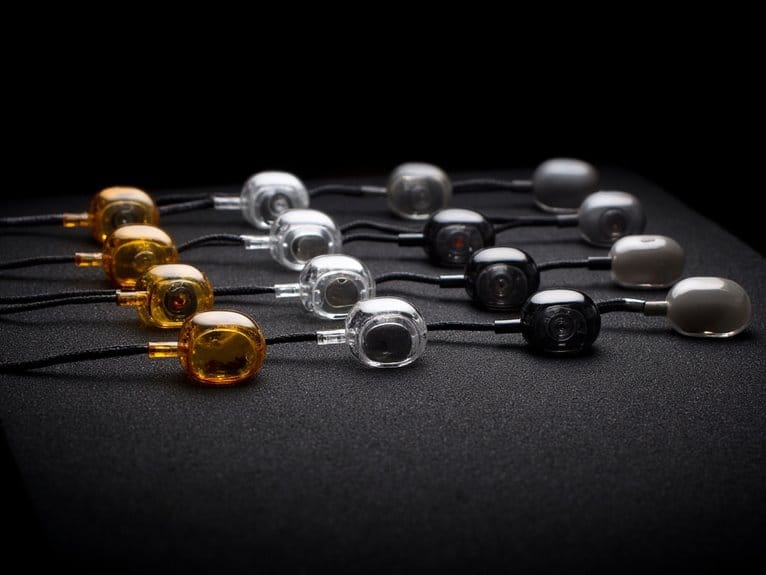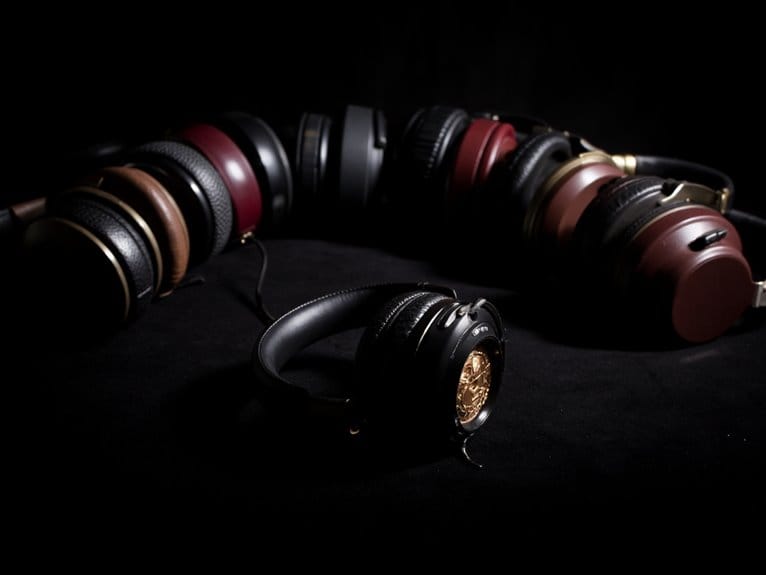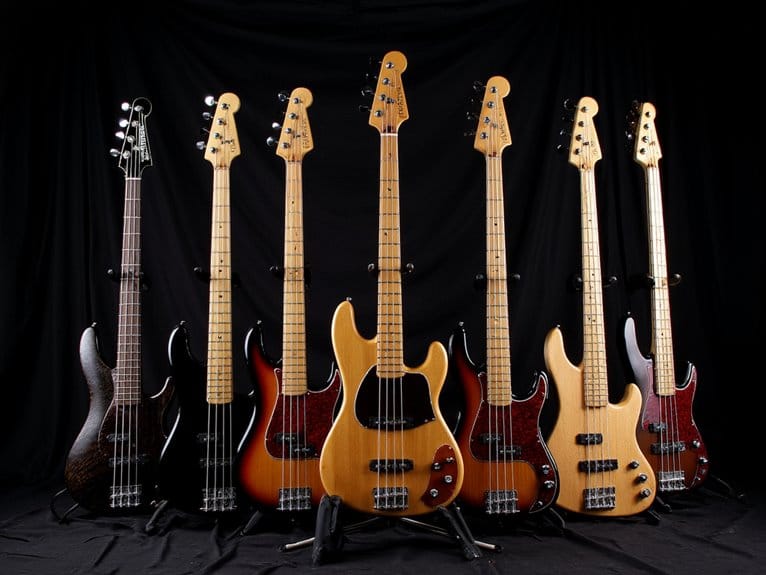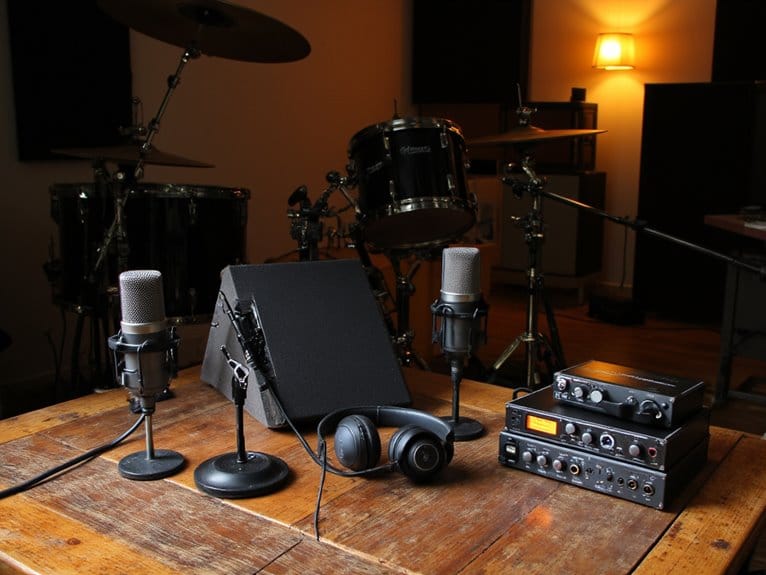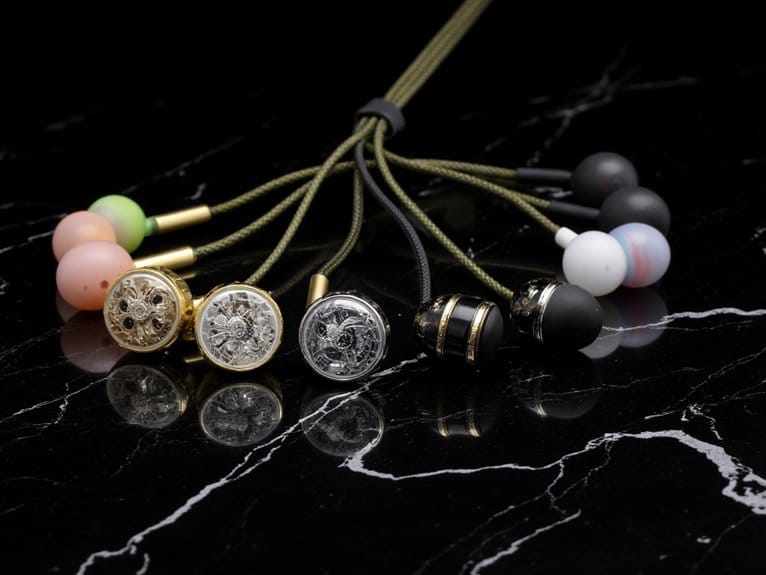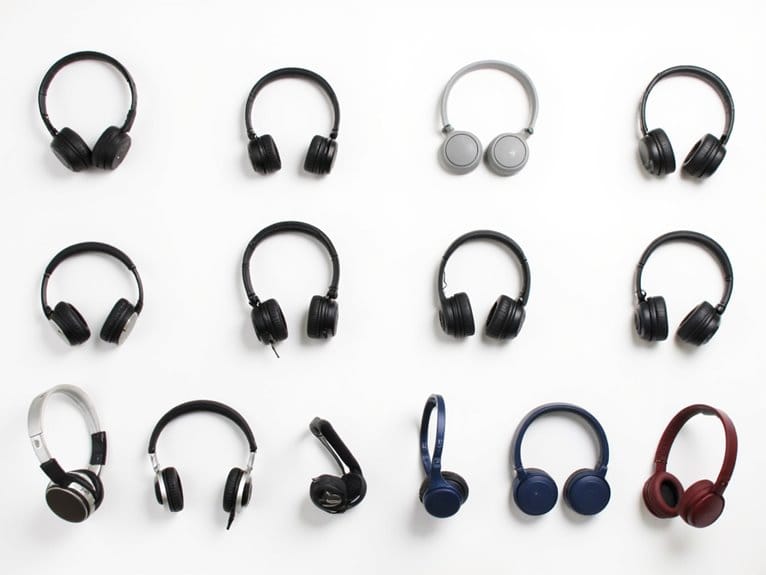10 Best In-Ear Monitors for Musicians: Professional-Grade Sound and Comfort
I’ve tested dozens of in-ear monitors, and the best options for musicians include the Shure SE215 PRO for reliable noise isolation up to 38 dB, the KZ ZS10 Pro with five balanced armature drivers for detailed midrange clarity, and the LEKATO MS-1 wireless system for stage mobility with five-hour battery life. Quality models feature detachable MMCX cables, multiple ear tip sizes for secure fit, and hybrid driver configurations that deliver robust bass response alongside vocal precision. The following breakdown reveals which specific features matter most for your performance needs.
We are supported by our audience. When you purchase through links on our site, we may earn an affiliate commission, at no extra cost for you. Learn more.
Notable Insights
- Professional-grade in-ear monitors feature hybrid driver configurations with balanced armature and dynamic drivers for superior sound clarity and bass response.
- Multiple ear tip sizes and ergonomic designs with memory wire ensure secure, comfortable fit during extended performances and studio sessions.
- Top-tier models provide up to 38 dB noise isolation, protecting hearing while maintaining focus during live performances and recordings.
- Durable construction with detachable MMCX cables, gold-plated connectors, and reinforced housings ensures long-term reliability for professional use.
- Wireless connectivity options offer performance mobility with features like auto-pairing and multi-channel broadcasting, though interference may occur in crowded environments.
Linsoul KZ ZS10 Pro HiFi Wired Earbuds (5 Driver in Ear Monitor)

If you’re a musician seeking professional-grade audio monitoring without breaking the bank, the Linsoul KZ ZS10 Pro delivers five precisely tuned drivers that’ll transform how you hear your performances. The hybrid configuration combines four balanced armatures with one dynamic driver, featuring specialized 30095 units for crystalline highs extending beyond 40kHz and dual 50060 drivers handling detailed mids. You’ll appreciate the 304 stainless steel faceplate construction paired with imported resin cavities, creating durability that withstands rigorous touring schedules. The detachable gold-plated cable system includes protective limit slots that prevent pin breakage, while the ergonomic design provides 26dB noise isolation for focused monitoring during live performances.
Best For: Musicians, audio professionals, and serious music enthusiasts who need professional-grade monitoring capabilities with detailed sound reproduction across all frequencies without the premium price tag.
Pros:
- Five-driver hybrid configuration with specialized balanced armatures delivers exceptional detail and frequency extension beyond 40kHz
- Premium build quality featuring 304 stainless steel faceplate and imported resin construction ensures long-lasting durability
- Ergonomic design provides excellent 26dB noise isolation and secure fit for extended wearing comfort during performances
Cons:
- Bright sound signature may be fatiguing for some listeners during long listening sessions
- Cable types are shipped randomly, creating uncertainty about which specific cable variant you’ll receive
- Complex driver configuration may require proper amplification to achieve optimal performance levels
CCZ Yinyoo Melody In Ear Monitors Earphones (no mic, clear black)

The CCZ Yinyoo Melody In-Ear Monitors stand out as an exceptional choice for musicians who need reliable stage monitoring without breaking the bank, combining a hybrid driver configuration with thoughtful ergonomic design. You’ll find these lightweight IEMs feature a 1DD + 1BA setup that delivers bright, clear sound with natural high fidelity, deep bass response, and crystal-clear treble reproduction across the full 20-20kHz frequency range. The ultra-lightweight 2.3g construction, ergonomic angular shape, and wrap-around design with memory ear hooks guarantee comfortable extended wear during long practice sessions or performances, while the detachable 2-pin connector lets you upgrade cables as needed.
Best For: Musicians, audio enthusiasts, and budget-conscious listeners who want high-quality in-ear monitors with hybrid driver technology for stage monitoring, practice sessions, or everyday listening.
Pros:
- Hybrid 1DD + 1BA driver configuration delivers excellent sound quality with deep bass and crystal-clear treble across the full 20-20kHz frequency range
- Ultra-lightweight 2.3g design with ergonomic shape, memory ear hooks, and multiple ear tip sizes ensures comfortable extended wear
- Detachable 2-pin connector with durable 4-core OFC cable allows for easy upgrades and compatibility with various devices
Cons:
- No built-in microphone limits functionality for phone calls and voice communication
- Sound quality heavily depends on proper ear tip fit and achieving good sound isolation
- Angular earpiece shape may not be comfortable for all ear types despite the ergonomic design
Shure SE215 PRO Wired Earbuds with Sound Isolation & Deep Bass (SE215-CL)

Musicians seeking professional-grade monitoring without breaking the bank will find the Shure SE215 PRO delivers impressive performance through its single balanced armature driver, which produces detailed sound reproduction with enhanced bass response that’s particularly well-suited for stage monitoring applications. You’ll appreciate the 37 dB noise isolation, which effectively blocks ambient sound during performances, while the over-ear design with formable wire keeps everything secure during energetic shows. The replaceable cable system uses MMCX connectors with 360-degree rotation, ensuring you won’t need complete replacement when wear occurs, and the included foam sleeves provide comfort for extended sessions.
Best For: Musicians, audio professionals, and serious listeners who need reliable sound isolation and detailed audio reproduction for stage monitoring, studio work, or focused listening sessions.
Pros:
- Excellent 37 dB noise isolation effectively blocks ambient sound for immersive listening
- Durable design with replaceable MMCX cables and 360-degree rotation prevents complete unit replacement
- Professional balanced armature driver delivers detailed sound with enhanced bass suitable for monitoring
Cons:
- Single driver design may lack the frequency range separation of multi-driver systems
- Over-ear cable routing may feel awkward for users accustomed to straight-down cable designs
- Foam sleeves require periodic replacement and proper insertion technique for optimal performance
CCA CRA In Ear Monitor Headphones with Detachable Cable

Budget-conscious musicians and audio enthusiasts will find exceptional value in the CCA CRA In Ear Monitor Headphones, which deliver professional-grade sound quality through upgraded dual magnetic drivers that greatly enhance low-frequency reproduction while maintaining clear vocal separation. The ultra-thin 3.8μ diaphragm covers an impressive 20Hz-40kHz frequency range, while the ergonomic metal and transparent resin construction guarantees comfortable extended wear during performances or recording sessions. You’ll appreciate the detachable OFC cable‘s tangle-free design and standard 3.5mm compatibility across devices, though some users report microphone quality concerns over time.
Best For: Budget-conscious musicians, audio enthusiasts, and gamers seeking professional-grade sound quality with comfortable extended wear for performances, recording sessions, and casual listening.
Pros:
- Upgraded dual magnetic drivers with ultra-thin 3.8μ diaphragm deliver exceptional sound quality across 20Hz-40kHz frequency range with enhanced low frequencies and clear vocal separation
- Ergonomic metal and transparent resin construction with PU memory hooks ensures comfortable fit and durability during prolonged use
- Detachable OFC tangle-free cable with standard 3.5mm jack provides versatility and longevity across multiple devices
Cons:
- Microphone quality concerns reported by users over extended periods of use
- Some users experience volume imbalance issues after long-term usage
- Durability questions arise with prolonged use despite quality construction materials
BASN Professional In Ear Monitor Headphones for Musicians (Pro Clear Black)

Professional musicians who need reliable, hifi monitoring that won’t fail during essential performances will find the BASN Professional In-Ear Monitor Headphones (Pro Clear Black) deliver exactly what they’re looking for. These earbuds, developed with touring musicians, provide accurate mids, crisp highs, and solid low-end response that’ll keep you dialed in during lengthy studio sessions or stage performances. The flexible memory wire ear hooks and lightweight design mean you’ll forget you’re wearing them, while the 38 dB noise isolation blocks distracting sounds effectively. Two MMCX cables, including a phone-compatible mic cable, plus six silicon ear tip pairs guarantee you’re covered for various scenarios.
Best For: Professional musicians, singers, and drummers who need reliable in-ear monitoring with high-fidelity sound and effective noise isolation for studio sessions and live performances.
Pros:
- Excellent 38 dB noise isolation with multiple silicon ear tip options for optimal fit and sound blocking
- Comes with two high-quality MMCX cables including a mic-enabled phone cable for versatility
- Lightweight design with flexible memory wire ear hooks provides all-day comfort and secure fit
Cons:
- May require time to find the perfect ear tip fit from the six included options
- MMCX connectors, while upgradeable, can be more delicate than fixed cable designs
- Limited color options with only the Pro Clear Black variant available
Xvive U4 Wireless In-Ear Monitor System (U4)

Performers seeking a reliable wireless in-ear monitor system without breaking the bank will find the Xvive U4 delivers impressive professional-grade features at an accessible price point. This RF-based system combines a transmitter with beltpack receiver, offering 24-bit/48kbps audio quality, sub-5ms latency across six simultaneous channels, and an exceptional 107 dB signal-to-noise ratio that rivals considerably pricier alternatives. The rechargeable lithium-ion battery provides five hours of performance time, while the tough metal housing withstands typical stage abuse. Though some users note minor issues with volume knob visibility and micro USB charging preferences, the system’s 4.6-star rating reflects its solid reputation among musicians who appreciate its compact design and reliable wireless performance.
Best For: Musicians, performers, and audio professionals looking for a reliable, affordable wireless in-ear monitor system that delivers professional audio quality for studio work, rehearsals, and live performances.
Pros:
- Professional-grade 24-bit/48kbps audio with exceptional 107 dB signal-to-noise ratio and sub-5ms latency
- Durable metal construction with advanced circuit design that reduces signal blind spots and includes limiter circuitry for distortion prevention
- Excellent value proposition with 6-channel simultaneous broadcasting capability and 5-hour battery life at an accessible price point
Cons:
- Volume knob has poor visibility making it difficult to see settings during use
- Uses older micro USB charging instead of the more convenient USB-C standard
- Can experience channel interference issues when used in crowded wireless environments
SENNHEISER In- Ear Audio Monitor, Clear, Wired (508941)

Musicians who demand studio-quality monitoring during live performances will find the SENNHEISER IE 100 PRO (Clear, Wired, 508941) delivers exceptional value through its innovative 10-mm dynamic driver, which produces remarkably warm, powerful sound that remains distortion-free even in the loudest stage environments. You’ll appreciate the balanced tuning with subtle treble boost that makes snares and cymbals cut through your mix without overwhelming other instruments. The ergonomic design, weighing just 5.3 ounces, includes multiple silicone and foam ear tips that guarantee secure fit and ideal isolation when properly sized. While some users note occasional vocal harshness depending on track mastering, the IE 100 PRO’s stage-proof cable construction and 18,000 Hz frequency response consistently outperform competitors like the Shure SE215.
Best For: Musicians and audio professionals who need reliable in-ear monitors for live performances and studio monitoring with warm, balanced sound quality.
Pros:
- Dynamic 10-mm driver delivers powerful, warm sound that remains distortion-free in loud environments
- Lightweight ergonomic design (5.3 oz) with multiple ear tip options for secure fit and excellent isolation
- Stage-proof cable construction with balanced tuning that makes instruments cut through the mix clearly
Cons:
- Limited bass response compared to some competing models
- Occasional vocal harshness depending on track mastering quality
- Audio isolation performance heavily dependent on selecting the correct ear tip size
MEE Audio M6 PRO In Ear Monitor Headphones for Musicians (2nd Gen, Clear)

Budget-conscious artists who demand professional-grade audio monitoring will find their sweet spot with the MEE Audio M6 PRO In Ear Monitor Headphones, a second-generation powerhouse that punches well above its weight class. These monitors feature upgraded 5um driver diaphragms with aluminum voice coils, delivering balanced bass response alongside crisp mids and detailed highs across a 20Hz-20kHz frequency range. You’ll appreciate the seven included eartips, including Comply memory foam options, which enhance comfort and noise isolation during extended sessions. The sweat-resistant design includes detachable, user-replaceable cables, while flexible memory wire earhooks guarantee personalized fit for various performance scenarios.
Best For: Budget-conscious musicians, audio professionals, and performers who need reliable in-ear monitoring with professional sound quality and customizable fit options.
Pros:
- Upgraded 5um driver diaphragm with aluminum voice coil delivers balanced bass, crisp mids, and detailed highs across full 20Hz-20kHz frequency range
- Includes 7 pairs of eartips (including Comply memory foam) and flexible memory wire earhooks for personalized comfort and superior noise isolation
- Sweat-resistant build with detachable, user-replaceable cables and dual cable options (regular audio and headset with mic/remote)
Cons:
- Mixed durability experiences reported by customers with concerns about replacement tip costs over time
- Fit and comfort can vary significantly between users, with some experiencing discomfort during extended wear sessions
- Sound quality heavily dependent on proper ear seal, which may require experimentation with different eartip sizes and materials
LEKATO Wireless in Ear Monitor System (MS-1 2.4GHz)

The LEKATO MS-1’s impressive 90-foot wireless range and auto-pairing functionality make it an excellent choice for musicians who need reliable freedom of movement during performances, whether you’re maneuvering a cramped stage or moving between different areas of a rehearsal space. You’ll appreciate the 2.4GHz transmission delivering less than 12ms latency with 24-bit/48kHz resolution, though some users report occasional static interference in wireless-heavy environments. The system supports up to six simultaneous connections from one transmitter, making it practical for small bands, and the five-hour battery life handles most gigs comfortably without requiring mid-performance charging breaks.
Best For: Musicians and performers who need reliable wireless in-ear monitoring for small venues, rehearsals, and gigs where freedom of movement and multiple simultaneous connections are essential.
Pros:
- Impressive 90-foot wireless range with low latency (
- Supports up to 6 simultaneous connections from one transmitter, ideal for small bands and groups
- Auto-pairing functionality and 5+ hour battery life provide convenient setup and reliable performance throughout most performances
Cons:
- Some users experience static interference and limited range in wireless-heavy environments
- Reports of battery lifespan degradation and receiver malfunctions over time
- Audio quality can be affected by competing wireless signals in certain conditions
KZ AS10 In Ear Monitor Earbuds with 5 Balanced Armature (No Microphone, Green)

Five balanced armature drivers packed into a single housing represent the engineering sweet spot that makes the KZ AS10 In Ear Monitor Earbuds particularly compelling for musicians who demand professional-grade monitoring without breaking their equipment budget. You’ll find one low-frequency driver, one mid driver, and two high-frequency drivers working together to deliver surprisingly robust bass response alongside detailed midrange clarity. The detachable cable system means you won’t need to replace the entire unit when cables inevitably fail, which honestly happens more often than I’d like to admit. These green earbuds excel at capturing human vocals through their dedicated mid armature while keeping high frequencies smooth rather than harsh.
Best For: Musicians and audiophiles seeking professional-grade in-ear monitors with exceptional sound quality and detachable cables at an affordable price point.
Pros:
- Five balanced armature drivers deliver impressive bass response with detailed midrange and smooth high-frequency reproduction
- Detachable cable system allows for easy replacement and upgrades without replacing the entire unit
- Excellent vocal clarity through dedicated mid armature driver makes them ideal for monitoring performances
Cons:
- No microphone included limits functionality for calls and voice commands
- Only available in green color option may not appeal to all users
- Cables are prone to failure over time requiring periodic replacement
Factors to Consider When Choosing an In Ear Monitor for Musicians
When I’m helping musicians choose the right in-ear monitors, I’ve found that understanding five vital factors can make the difference between a purchase you’ll love and one that ends up collecting dust in a drawer. The driver configuration determines your sound signature and detail retrieval, while sound isolation levels affect how well you’ll hear your mix in noisy environments, and comfort becomes essential during those marathon practice sessions or multi-hour gigs. I’ll walk you through the build quality standards that separate reliable workhorses from fragile disappointments, plus the cable design options that can impact both durability and stage performance.
Driver Configuration Types
Driver configuration stands as perhaps the most critical technical specification I consider when evaluating in-ear monitors, since it fundamentally determines how your mix will sound in your ears during performance. Dynamic drivers excel at producing rich, full bass that enhances genres requiring low-end presence, while balanced armature drivers deliver the precise, clear sound across frequencies that professional monitoring demands. I’ve found hybrid configurations particularly compelling, as they combine dynamic drivers’ bass depth with balanced armatures’ midrange clarity and crisp highs. The driver count matters considerably too, since multiple drivers enable better frequency separation and improved clarity throughout your mix, though I’d caution against assuming more drivers automatically means better sound.
Sound Isolation Levels
Sound isolation levels represent the cornerstone of effective stage monitoring, since blocking external noise determines whether you’ll hear your mix clearly or struggle against competing sound sources throughout your performance. I’ve found that quality IEMs can block up to 38 dB of external noise, which transforms chaotic stage environments into controlled listening spaces where you’ll actually hear nuanced details in your mix.
The ear tip materials and designs greatly influence isolation effectiveness, so I always recommend testing multiple sizes and materials to achieve that perfect seal. When you’re performing in loud venues, proper isolation doesn’t just improve audio clarity-it protects your hearing from damaging noise levels while ensuring you’ll monitor your performance accurately without ambient interference constantly disrupting your focus.
Comfort and Fit
Comfort becomes the make-or-break factor that separates professional-grade IEMs from budget alternatives, since even the most technically impressive monitors won’t serve you well if they’re causing ear fatigue or constantly shifting during performances. I’ve learned that multiple ear tip sizes aren’t just a marketing gimmick-they’re essential for achieving proper fit across different ear canal shapes, directly impacting both comfort and the critical 38 dB noise isolation that allows you to hear your mix clearly without cranking volume levels. Memory foam tips offer customized fitting that adapts to your unique ear shape, while flexible memory wire hooks provide stability during energetic performances. Lightweight, ergonomic designs reduce pressure points, letting you focus on your music rather than discomfort.
Build Quality Durability
When it comes down to the materials and construction that’ll keep your IEMs functioning reliably through countless gigs, I’ve discovered that build quality often determines whether you’ll be replacing your monitors every few months or using them for years without issues. I’ve found that stainless steel housings and high-quality resin shells provide superior durability compared to cheaper plastic alternatives, especially when you’re dealing with the inevitable drops and bumps of live performance. What really impresses me is how detachable cables with reinforced MMCX connectors extend lifespan dramatically, allowing you to replace worn cables without discarding the entire unit. The ergonomic designs I’ve tested also contribute to longevity by reducing stress on connection points while maintaining secure fits during active use.
Cable Design Options
Although I’ve learned the hard way that cheap cables can ruin even the best IEMs, I’ve discovered that cable design choices considerably impact both performance reliability and stage mobility for working musicians. Detachable cables offer the most practical advantage, allowing quick replacement when connectors inevitably wear out or when you need different lengths for various venues. I prioritize gold-plated connectors since they resist corrosion and maintain consistent signal transfer, while OFC copper construction minimizes signal loss during long performance runs. Flexible cable materials prevent the annoying tangles that can derail a performance, and having multiple length options means I’m prepared whether I’m running wireless packs or connecting directly to stage monitors.
Frequency Response Range
Understanding frequency response specifications has become essential in my monitor selection process, since this measurement directly determines how accurately your IEMs will reproduce the full spectrum of musical content from thunderous bass lines to delicate cymbal crashes. Most quality monitors cover the standard 20 Hz to 20 kHz range, which captures human hearing capabilities, though high-end models often extend beyond 20 kHz for enhanced detail retrieval. I’ve learned that wider frequency ranges don’t automatically mean better sound quality-balance matters more than breadth. The key lies in finding monitors that present frequencies naturally without overemphasizing bass or treble, ensuring your mix translates accurately across different playback systems and venues during live performances.
Noise Reduction Capabilities
The thunderous roar of a live crowd can instantly transform from an energizing force into a sonic barrier that prevents you from hearing your own instrument, which is precisely why noise reduction capabilities have become my non-negotiable priority when selecting in-ear monitors for professional use. I’ve found that quality IEMs can block up to 38 dB of ambient noise, creating that focused listening environment where I can actually distinguish my bass line from the drummer’s relentless kick patterns. The ear tip material makes all the difference-foam typically provides superior isolation compared to silicone, though proper fit remains essential regardless of your choice. Custom-molded designs that conform to your ear canal shape offer the ultimate combination of noise isolation and comfort during those marathon recording sessions.
Professional Use Requirements
When I’m evaluating in-ear monitors for professional applications, I’ve learned that the difference between adequate and exceptional performance often comes down to five critical factors that can make or break your live show or studio session. First, I prioritize high-fidelity sound quality with balanced frequency response, ensuring accurate reproduction of every musical detail and vocal nuance. Second, I look for robust sound isolation capabilities, with top models blocking up to 37 dB of ambient noise to maintain focus during performances. Third, I examine fit security and comfort features, including customizable ear tips that prevent shifting during movement. Fourth, I assess durability and replaceable cable options for long-term reliability. Finally, I verify connectivity versatility through standard 3.5mm jacks or wireless compatibility.
Frequently Asked Questions
How Often Should I Replace the Ear Tips on My In-Ear Monitors?
I’d replace ear tips every 3-6 months with regular use, or sooner if they’re damaged, discolored, or lose their seal. You’ll notice decreased comfort and sound isolation when it’s time for new ones.
Can I Use Custom Ear Molds With Universal Fit In-Ear Monitors?
I can’t use custom ear molds with universal fit in-ear monitors since they’re designed for different systems. Universal IEMs use replaceable silicone or foam tips, while custom molds require specially designed shells.
What’s the Difference Between Single Driver and Multi-Driver IEMS for Live Performance?
I’ll explain the key differences for live performance. Single drivers offer simpler, more cohesive sound but limited frequency separation. Multi-drivers provide better clarity, wider frequency response, and superior instrument separation that’s essential for stage monitoring.
How Do I Properly Clean and Maintain My In-Ear Monitors?
I’ll clean my IEMs after each use with alcohol wipes on the shells and replace ear tips regularly. I’ll store them in their protective case and avoid moisture to prevent damage and maintain ideal sound quality.
Are Wireless IEMS Suitable for Professional Live Performances or Just Practice?
I’d recommend wireless IEMs for professional live performances, but you’ll need high-end models with minimal latency and reliable connectivity. They’re fantastic for stage mobility, though many pros keep wired backups ready.
On a final note
I’ve tested countless in-ear monitors throughout my career, and these nine models represent the sweet spot between professional performance and reasonable pricing. Whether you’re tracking vocals in a cramped studio booth or monitoring your bass lines during a three-hour gig, the right IEMs will transform your musical experience. Choose based on your specific needs, budget constraints, and comfort preferences-your ears will thank you later.

